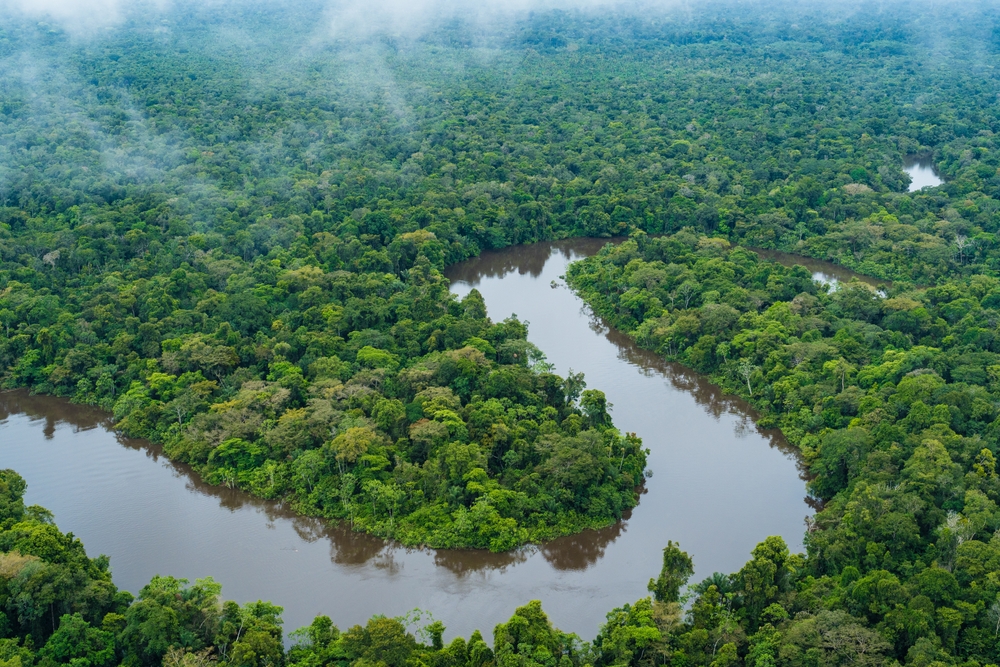Swathe of Amazon Chopped Down to Make Way for Road for COP30 Climate Summit

Over eight miles of the Amazon rainforest have been cleared to construct a road ahead of the COP30 climate summit. Set to take place in Belém, Brazil, in November 2025, the conference is expected to draw more than 50,000 delegates, including global leaders, scientists, and activists.
The road aims to improve traffic flow and infrastructure as the city prepares to host one of the most high-profile environmental events in the world. But the move has drawn strong criticism from environmental groups, scientists, and local residents, who see the destruction as a contradiction—cutting down part of the world’s most vital forest to make room for conversations about protecting it.
Photos from the site show a dirt highway slicing through once-dense forest. Trees that stood for decades now lie stacked in piles. The hum of machinery has replaced the forest’s natural rhythm.
This development raises a question that deserves urgent attention: Can any action be called sustainable if it requires irreversible environmental harm?
Details of the Road Project

The newly constructed road is part of a broader infrastructure plan launched by the state government of Pará. Officials argue that the project is necessary to manage the expected surge in traffic during COP30, when thousands of delegates and support staff will arrive in Belém.
According to Adler Silveira, Pará’s infrastructure secretary, the road is designed to be “sustainable.” Plans include wildlife crossings, solar lighting, and bike lanes—features intended to limit the ecological footprint of the development. Local officials also describe the project as an “important mobility intervention,” claiming it will improve long-term access for surrounding communities.
The idea for the road was first proposed in 2012 but remained on hold for years due to environmental concerns. As COP30 approached, construction was revived and accelerated to meet the summit’s deadline.
Despite assurances from government officials, conservationists and residents remain unconvinced. The scope of the deforestation, combined with the speed of the project’s execution, has fueled concern that the environmental costs were never fully accounted for.
What began as a logistical upgrade has now sparked a broader debate—one that stretches far beyond traffic management and conference planning.
How Eight Miles Disrupted Centuries of Life

Clearing eight miles of Amazon rainforest carries consequences that extend far beyond the visible damage. The Amazon is one of the most biodiverse regions on Earth. Removing even a small portion interrupts complex ecosystems that have evolved over centuries.
Wildlife habitats have been split in half. Species that once moved freely now face barriers that limit their ability to find food, breed, or return to familiar territory. Professor Silvia Sardinha, a wildlife veterinarian and researcher, warned, “From the moment of deforestation, there is a loss.” Her concern is not hypothetical—fragmented forests reduce biodiversity and expose species to increased risk of extinction.
Satellite imagery and on-the-ground photos show vast corridors of land stripped of vegetation, littered with piles of felled logs. In place of green canopy, bare soil stretches toward the horizon. The sounds of birds and insects have been replaced by the mechanical rhythm of excavators and trucks.
These disruptions are not isolated. Deforestation opens paths for further encroachment—legal or illegal. Roads often become the starting point for expanded development, which may lead to more clearing, more displacement, and more irreversible loss.
What has been cut cannot be reassembled. Replanting trees does not restore an ecosystem. Once the soil is disturbed, once the balance is broken, recovery is uncertain—if it happens at all.
When Livelihoods Are Uprooted Alongside Trees

The forest is more than a symbol—it’s home. For thousands of families living near the new road, the rainforest provides food, income, and identity. When trees fall, so do the lives built around them.
Claudio Verequete knows this firsthand. He supported his family by harvesting açaí berries from trees near his home. That harvest is gone. Bulldozers didn’t just remove trees—they erased his way of life. “Our harvest has already been cut down. We no longer have that income to support our family,” he told the BBC. With no compensation from the government, Claudio now relies on savings to survive.
His story is not isolated. Across the Amazon, communities rely on the forest for work, medicine, and sustenance. Roads often bring the promise of progress, but for many locals, they arrive without warning and without support. Land is cleared. Income vanishes. Families are left to absorb the impact alone.
There’s also the fear of what comes next. Once a road is built, it rarely stops there. New development often follows—warehouses, gas stations, further clearing. Claudio voiced a concern shared by many in his community: “Our fear is that one day someone will come here and say: ‘Here’s some money. We need this area.’ And then we’ll have to leave.”
For those born and raised in the forest, displacement isn’t just physical—it’s generational. Roots run deeper than land titles. When people are forced out, culture and memory are uprooted, too.
Contradictions in Climate Action

COP30 is expected to be one of the most significant environmental gatherings in recent years. Yet the lead-up to this event has exposed a contradiction that’s hard to ignore—clearing rainforest to host a climate summit designed to protect it.
Government officials call the road “sustainable.” The word appears in press briefings and infrastructure plans, often paired with features like solar panels and bike lanes. But for conservationists, scientists, and affected communities, the label rings hollow when the foundation of the project is destruction.
The symbolism is striking. A conference meant to spotlight Amazon protection now has, as its backdrop, images of felled trees and displaced wildlife. That contradiction risks eroding trust—not just in this summit, but in the broader climate movement.
Sustainability cannot rely on optics. It requires decisions that align with long-term ecological and social well-being. Otherwise, promises lose weight, and actions send mixed messages to the world.
The concern isn’t limited to optics. Decisions like this raise difficult questions about the standards used to justify environmental trade-offs. Who gets to define what is “sustainable”? What is lost in the process of progress? And who bears the cost?
As global leaders prepare to gather in Belém, the road leading there has become more than a route—it’s a reminder. Climate action must not compromise the very principles it aims to protect.
Reflecting on Sustainable Development

True sustainability goes beyond intention—it lives in the consequences of action. Projects that carry an environmental cost, no matter how well-intentioned, require more than hopeful language. They require honesty.
Clearing a path through one of the most ecologically vital regions on Earth, just to host a climate event, forces a deeper conversation about what is being prioritized—and what is being sacrificed. Sustainability is not defined by the inclusion of green technologies. It’s defined by whether the natural and human systems that support life are preserved, not just compensated for.
Development does not need to mean destruction. But when forests are cut without fully weighing long-term consequences, or when local communities are left out of planning and protection, the approach fails both ecologically and ethically.
There is a growing call, especially among scientists and Indigenous leaders, to rethink how sustainability is measured. The focus must shift from convenience to continuity—from short-term gains to long-term stewardship.
Infrastructure, when truly sustainable, works with nature, not around it. It strengthens communities rather than placing them at risk. And most importantly, it holds itself accountable to the values it claims to uphold.
The road built for COP30 has created more than a physical passage—it has opened a space for reflection on how progress is defined, and who gets to define it.
A Clearer Path Starts with Honest Ground

Building a road through the Amazon to host a climate summit reveals more than poor planning—it reveals a disconnect between words and action. The destruction of one of Earth’s most vital ecosystems, in the name of global environmental dialogue, invites more than criticism. It demands accountability.
There is no climate solution that justifies silencing the forest to speak about saving it.
Sustainability must be measured not by how green a project appears, but by how little it harms. When trees fall, species vanish, and families lose their livelihoods, no solar panel or bike lane can offset the damage.
The road to COP30 was paved with contradictions. But it can still lead to something useful—clarity.
Clarity that sustainability is not a slogan, but a responsibility.
Clarity that real progress listens before it builds.
Clarity that protecting the planet means protecting people, forests, and futures—not just platforms and agendas.
Now is the time to ask harder questions, demand better answers, and move beyond convenience. Not for the sake of symbolism, but because the rainforest, the people who depend on it, and the life it supports, deserve more than hollow promises.
If climate action is to mean anything, it must begin with consistency—starting with the very ground we choose to stand on.
Featured Image Source: Shutterstock
Loading...






